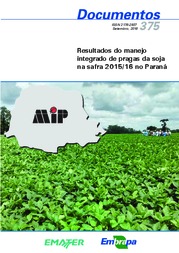Resultados do manejo integrado de pragas da soja na safra 2015/16 no Paraná.
Resultados do manejo integrado de pragas da soja na safra 2015/16 no Paraná.
Autoria: CONTE, O.; OLIVEIRA, F. T. de; HARGER, N.; CORRÊA-FERREIRA, B. S.; ROGGIA, S.; PRANDO, A. M.; SERATTO, C. D.
Resumo: The root is an important organ which supplies water and nutrients to growing plants. Data related to root growth and nutrient uptake by tropical legume cover crops are limited. The objective of this study was to evaluate root growth of tropical legume cover crops and nutrient uptake and use efficiency under different phosphorus (P) levels. The P levels used were 0 (low), 100 (medium) and 200 (high) mg kg¡1 of soil and 5 cover crops were evaluated. Root dry weight, maximum root length, specific root length were significantly in fluenced by P and cover crop treatments. Maximum values of these root growth parameters were achieved with the addition of 100 mg P kg ¡1 soil. The P X cover crops interaction for all the macro and micron utrients, except manganese (Mn) was significant, indicating variation in uptake pattern of these nutrients by cover crops with the variation in P rates. Overall, uptake pattern of macronutrients was in the order of nitrogen > calcium > potassium > magnesium > phosphorus (N > Ca > K > Mg > P) and micronutrient uptake pattern was in the order of iron > manganese > zinc > copper (Fe > Mn > Zn > Cu). Cover crops which produced maximum root dry weight also accumulated higher amount of nutrients, including N compared to cover crops which produced lower root dry weight. Higher uptake of N compared to other nutrients by cover crops indicated that use of cover crops in the cropping systems can reduce loss of nitrate (NO 3¡) from soil-plant systems. Increase in root length and root dry weight with the addition of P can improve nutrient uptake from the soil and less loss of macro and micronutrients from the soil-plant systems.
Ano de publicação: 2016
Tipo de publicação: Livros
Unidade: Embrapa Soja
Palavras-chave: Controle integrado, Praga de planta, Soja, integrated pest management, plant pests, soybeans
Observações
1 - Por padrão são exibidas publicações dos últimos 20 anos. Para encontrar publicações mais antigas, configure o filtro ano de publicação, colocando o ano a partir do qual você deseja encontrar publicações. O filtro está na coluna da esquerda na busca acima.
2 - Para ler algumas publicações da Embrapa (apenas as que estão em formato ePub), é necessário ter, no celular ou computador, um desses softwares gratuitos. Sistemas Android: Google Play Livros; IOS: iBooks; Windows e Linux: software Calibre.
Acesse outras publicações
Acesse a Base de Dados da Pesquisa Agropecuária (BDPA) para consultar o acervo completo das bibliotecas da Embrapa.

